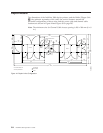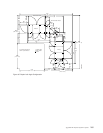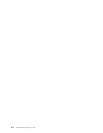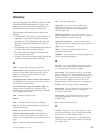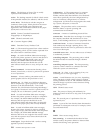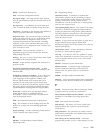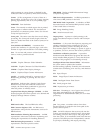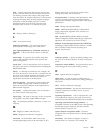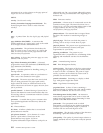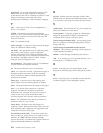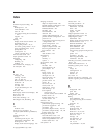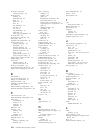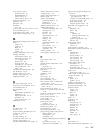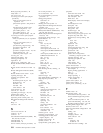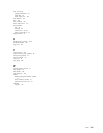orientation of an overlay relative to the page point of
origin. See also text orientation.
OS/VS.
overlay. See electronic overlay.
Overlay Generation Language/370 (OGL/370). The
licensed program that is used to create electronic
overlays.
P
page. A printed form. See also logical page and physical
page.
page definition (PAGEDEF). A statement that
specifies attributes of a logical page, such as the width
of its margins and the orientation of text.
page perforation. The perforation that defines the
page of a form. It may or may not be at a fold in the
form. A form may have several pages between each
fold. See also fold perforation.
page printer. A device that prints one page as a unit.
Contrast with line printer.
Page Printer Formatting Aid (PPFA). A licensed
program that creates form definitions (FORMDEFs) and
page definitions (PAGEDEFs).
pallet. A portable platform for handling, storing, or
moving materials.
paper break. A separation, either at a perforation or
from a tear, of the continuous-forms paper.
paper path. The entire route that forms travel while
they are being processed. The paper path usually
begins where the forms are loaded and ends at the
stacker. Because not all forms are paper, the term forms
path is preferred.
parallel channel. A channel having a System/360 or
System/370 channel-to-control unit interface that uses
bus-and-tag cables as a transmission medium. Contrast
with ESCON channel.
parameter. A variable that is given a constant value
for a specified application and that may denote the
application.
PC. Photoconductor.
PC drum. A hollow cylinder that is covered with
photoconductive material.
pel (picture element). (1) An element of a raster
pattern; a point where a toned area on the
photoconductor may appear. (2) On an
all-points-addressable output medium, each pel is an
addressable unit. On a row-column addressable output
medium, the only pel addressable is the beginning of a
character cell.
PEM. Print-error marker.
perforation. A linear series of unconnected cuts in the
continuous-forms paper. The interval between cuts is
referred to as a tie. The perforation defines either a fold
or page boundary. See also cut, fold perforation,
microperforation, and page perforation.
photoconductor. The material that is wrapped about
the drum. The medium for transferring images to
paper.
physical page. The form on which the printer is
printing, such as an 8½ x 11-inch sheet of paper.
physical planner. The person in an organization who
plans the environmental, electrical, and space
requirements for your facility.
planning coordinator. The person in your
organization who is responsible for coordinating all the
planning and installation activities for the InfoPrint
3000.
plant. A manufacturing location.
PMF. Print Management Facility.
point of origin. The location of the first print position
on a logical page. The point of origin is usually stated
in terms of X and Y coordinates. The point of origin
used by a printer can be affected by factors such as
printable area and forms orientation.
portrait orientation. Pertaining to a display or hard
copy with greater height than width.
PPFA. Page Printer Formatting Aid.
preprinted form. A sheet of forms containing a
preprinted design of constant data with which variable
data can be combined. See also electronic overlay.
Print Management Facility (PMF). An interactive
menu-driven program that can be used to create and
modify fonts and to define output formatting for data
printed on the IBM InfoPrint 3000.
print mode. The operational mode in which
information is received from the attached controlling
computer system and printed output is produced.
Contrast with test mode and diagnostic mode.
print position. The physical positions of the characters
constituting a print line relative to the form.
print quality. The quality of printed output relative to
existing standards and in comparison with jobs printed
earlier.
302 InfoPrint 3000 Operator’s Guide



